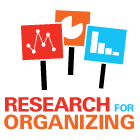Download
Entire
Chapter
PRESENTING AND PACKAGING THE REPORT
This section is designed for whomever will be responsible for writing, designing, and packaging the research. This section has no group activities and consists entirely of tools to assist you in this phase.
Download
Tool 6.1
Tool: 6.1 Model Outline of Report
Description:
Below is an outline of contents that typically go in a participatory action research report. You may need to add and omit sections, depending on your organization and issue of focus
Contents:
Preface Sections:
1. About the Authors: List the organization(s) with a brief description of the mission and work. Include organizational logos if possible.
2. Acknowledgements: Acknowledge all of the individuals, organizational partners, members, and funders that made the report possible.
3. Foreword: Including a foreword from a well-known public figure or scholar can help raise the profile of your report and draw in readers.
4. Table of Contents: Present all of the sections of the report with corresponding page numbers in a clear and concise manner. You may also want to include a list of all the tables and charts in your report.
The Report:
5. Executive Summary: Should concisely summarize the report. Because this is the section that will be read the most, it should include the most significant research findings, data and policy recommendations.
6. Introduction and Background: Use this section to frame your report and to introduce the issue and/or community of focus. This section can include pertinent historical information, secondary data and a review of literature.
7. Research Methods: Describe of all of the research methods you used in the report. Include demographic information about your research sample, the sample strategy you used, who conducted the research, when the research was conducted and any challenges or limitations to your research that may have significantly impacted your findings.
8. Research Findings: Present all of your significant research findings from the data you collected in this section. Consider formatting this section by research finding including a brief background, summary of the finding, and relevant quantitative and qualitative data that supports the finding. Look for creative ways to present your quantitative data (charts, tables, graphs etc.), and your qualitative data (pullout quotes, individual member profiles or biographies with photos). Try to present the data so that the most important findings pop out the most.
9. Political Context: Describe the present political climate with information about relevant laws, legislation, and government funding related to the issue. This section should lay the foundation for the specific policy recommendations you propose in the following section.
10. Policy Recommendations: This section should present your policy recommendations in bulleted and easy to read format. Each policy recommendation should be directed at one or more specific entity that has the power to create or implement the policy you are recommending.
11. Conclusion: This section should sum up the main points of your report and include the core information you want the reader to take away after reading the report. It should also be inspirational, forward looking and act as a sort of “call to action” for the reader.
12. Appendix: Include addendum documents or information that clarify or strengthen your argument. Often appendix sections include tables, charts, and graphs of relevant information that are too bulky or too detailed to include in the body of the report. This can also include additional details from your methodology or a glossary of terms or acronyms that you use throughout the report.
13. Endnotes/Footnotes: Put all of your citations in this section; consider also including a bibliography of works cited. There are different formats you can use for citing works, but be sure that whatever format you chose, you are consistent for all of your footnotes or endnotes. Some types of publications, such as very technical or legal reports, may require footnotes but usually endnotes will suffice. Additional resources on citations include:
http://www.lib.berkeley.edu/instruct/guides/citations.html
Download
Tool 6.2
Tool: 6.2 Design & Printing Resources
Description:
The look, design, and quality of printing utilized for your report is significant! A report that looks sloppy or unprofessional may get discarded by public officials and media. There are a number of design resources that exist in the case that you need to seek support outside of your organization.
Social Justice Graphic Designers
There are a number of organizations that do graphic design and have a social justice analysis guiding their work. Some groups include:
- The Center for Urban Pedagogy– Based in Brooklyn, CUP’s mission is to use design and art to improve public participation in shaping the places where we all live. CUP projects bring together art and design professionals – artists, graphic designers, architects, urban planners – with community-based advocates and researchers – organizers, government officials, academics, service-providers, policymakers. http://www.anothercupdevelopment.org/
- Design Action– Based in Oakland, Design Action provides graphic design and visual communications for progressive, non-profit and social change organizations. By providing these high-quality professional services, we seek to contribute to building a broad and effective progressive movement and participate in the struggle for social justice. Design Action is affiliated with Inkworks Press-a democratically run worker collective that specializes in green printing services. http://designaction.org/
- Hester Street Collaborative– Based in New York City, Hester Street Collaborative’s (HSC) mission is to empower residents of underserved communities by providing them with the tools and resources necessary to have a direct impact on shaping their built environment. We do this through a hands-on approach that combines design, education, and advocacy. http://hesterstreet.org/
- Justseeds Artists’ Cooperative is a decentralized network of 26 artists committed to making print and design work that reflects a radical social, environmental, and political stance. http://justseeds.org/about/who_we_are.html
- Free Range Studios– We’re a team of passionate, wildly creative people who spend our days strategizing, branding and designing so the most important social messages get through loud and clear. http://www.freerange.com/about-us.html
Individual Graphic Design Consultants
There are a number of individual graphic designers that focus on design for social justice organizations.
- Rosten Woo: http://rostenwoo.biz/
- Chris Chaput: christopher.chaput@gmail.com
